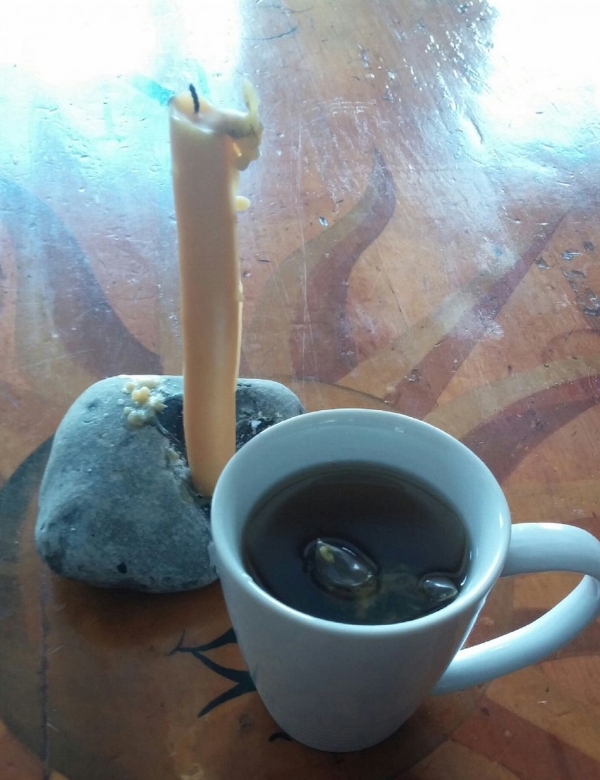Sacred Tea Ceremony
Many of us think of the Japanese tradition when we hear “Tea Ceremony” and they definitely have one of the worlds most beautiful and sacred ways of making tea a healing practice. Tea ceremonies have been done in different ways in many other cultures also. The English are famous for their afternoon teatime and a tea culture exists in many other countries where tea making is sometimes ritualized and sometimes just a part of daily life as is our American coffee culture. Many ‘hip’ communities in the United States now have “tea rooms” where people can gather and drink tea together while relaxing and visiting. There is even an “American Tea Ceremony” now that has been adapted from the Japanese version.
Making tea is a significant part of using herbal medicine although it is not the fastest or most concentrated method of administering herbs. Still, it is a central activity in this ancient healing tradition and water based preparations were actually easier and more accessible to people at one time. Herbs could be easily gathered and dried for use all year with their medicine preserved and re-ignited during the tea making process.This is not a quick, swallow a pill or “take it on the go” way to receive herbal medicine which is part of why teas can be so sacred and self-nourishing. To make oneself a cup of tea takes time and time is a dwindling resource in our fast-paced production oriented modern lives. The act of making and drinking tea is part of "tea medicine" and it is one of my favorite recommendations for my clients with anxiety. I always remembered my Social Psychology professor saying that one of the best ways to remedy a panic attack was to get the person to breath. The change in focus was often enough to redirect the person's energy and distract the stress response. I think of taking a tea break as a similar process in the midst of a high intensity society. When I was a young mother and so busy all the time caring for others, making tea was a moment of grace and respite even amongst the household busyness, demands and oftentimes chaos that seemed to be swirling around me. Just the act of pouring water over a tea bag can offer us an opportunity to take a deep breath and stand still for a moment. The time it takes to steep a cup of tea, although we may go off and do other things while it’s happening, still calls us to hold space for our own nourishment. We may be sweeping or folding or wiping, but we have that cup of tea steeping on the counter in our minds and, in just that simple thought, we are caring for ourselves. This is slow medicine and swallowing a pill or take a squirt of tincture will not produce the same results.
To make an herbal tea you may follow these simple steps:
Choose your tea or tea blend. You can either make your own or choose from the many herbal tea blends on the market.
Boil water in a tea kettle. The water has to be boiling for most herbs to break through the cell wall and extract the medicinal compounds.
3. Pour the water over your tea bag or tea ball
4. Let steep for 10-15 minutes
5. Strain and drink
***or more detailed information about making tea and water-based preparations you can go to my previous post Here
Do-it –yourself Tea Ceremony
Set aside 30 minutes or longer of quiet time when you can be alone or at least in another room or your house. It’s super special if you can take your tea outside in your garden or anywhere . If you want to do this with others you can still make it a quiet time of contemplation or choose some focused topics or thoughts to share
Make a cup of tea as directed above but stay present with each step of the process by following this tea making movement meditation
As you turn the knob on your stove and the flame or burner ignites beneath your teapot exhale and release as much tension as you can while bringing your mind to the present. Think about the wondrous nature of water and how grateful you are for its life giving action.
While the water boils prepare your tea. If you are mixing your own blend put each herb into your tea press or tea ball one by one. Acknowledge the medicinal qualities of each herb and say ‘thank you’. If you are using a tea bag, name(say aloud or to yourself) each herb and give thanks for its medicinal qualities.
When the water is boiling, turn off the burner and inhale. Pour the water over the tea and exhale. Imagine that the water and tea are now merging into one as they meet, react and transform into medicine. Watch the steam as it rises from your cup.
While your tea steeps gaze into the mug and imagine that it is a deep well of water. Visualize any intentions that you have for that day and see them emerging in the reflection of your tea.
Find a relaxing quite place to sit and drink your tea and allow yourself to just be. If your mind wanders let it. If you feel called to draw or journal now, do so. Deeply taste each sip of tea and notice the way it feels on your tongue. Notice what flavors you can taste and imagine all of the nutritional support you are receiving.
Take time to do this as often as you can, but at least once a day is optimal. Don’t make it too rigid, make it your own, add your own twist to it. Also, don’t be afraid to modify and make it shorter or longer. Invite others to join you if you can’t be alone. Once a week or once a month is better than never.
Options:
Light a candle on your counter or wherever you make your tea.
Light a candle to sit by while you drink your tea
Play some sacred music in the background
Create a tea space or tea room in your house. It can even be a closet. I have a friend who cleaned out a closet and made herself a meditation room. She had six children and this was her sacred space of respite and centering. The kids could even join her and they would enjoy some peaceful downtime together. And what great role-modeling for our children to observe us taking time for ourselves as we hope that they respect themselves enough to do also.
ome herbal ideas for tea making
Tea blending itself is an art form, but to start just keep simple with 2 or 3 different herbs.
Sacred Basil/Tulsi(Ocimum sanctum)~Sacred Basil is a great substitute for caffeinated teas. Not because it is similar in taste but because it is uplifting, mind clearing and centering while at the same time contains no caffeine so is not over-stimulating to the nervous system. For more on Sacred Basil go Here
Nettles(Urtica dioica)~Is one of the most highly nourishing herbs we have. It is high in many essential minerals and is strengthening, tonifying and overall life enhancing.It relieves fatigue, stabilizes blood sugar and regulates metabolism. Nettles gently restores balance and resilience
Red Raspberry leaf(Rubus spp.)~Often known as a woman's herb, Red Raspberry is a tonic for the uterus and so is a great choice during menstruation, pregnancy and anytime during the phases of a woman's life
Lemon Balm(Melissa officinalis)~Is uplifting, yet calming, anti-depressant and contains anti-viral properties
Roses(Rosa spp.)~are a nervine having a calming effect on the nervous system. Roses taste delicious and smell divine while they open the heart and uplift the mind
Skullcap leaf(Scutellaria laterfolia)~great for anxiety, burn-out, and sleep irregularity. Skullcap used for insomnia is best made with warm instead of boiling water but mixed in a tea blend for overall anxiety can be made as tea.
Catnip(Nepeta cataria)~Calming, eases upset stomach, generally tasty and relaxing
Linden Flower(Tilia europaea or Tilia americana-American Basswood)~Linden relieves nervous tension and is tonic to the circulatory system. It's a nice calming herb for children and used for ADHD
Hawthorne Leaf, Flower, and/or Berry(Crataegus spp.)~Hawthorne is tonic to the cardiovascular system, is nervine and antioxidant. I love Hawthorne for any type of grief or heavy-hearted sadness. It relaxes the nervous system and is great for anxiety, irritability, ADHD(especially with Tulsi and Linden flower), and any type of restlessness.
You can mix and match or use each of these on their own. Just blend proportions to your personal taste.
Sources of loose herbs for tea
Healing Spirits Herb Farm They also have their own line of teas here and I love them!
My favorite tea blends:
Mandala Centering Tea from Jeans Greens. There are several great tea blends here and any tea accessory you might wish for!
Love Tea from Pukka
I usually blend my own in the moment based on what I feel like, but sometimes it's nice just to throw in a tea bag and not have to come up with something.
Making tea is a practice from ancient times and when we share in this tradition it re-connects us to an old way of being in the world that is so needed in our new times. It is also a practice that is flexible and simple enough that it fits nicely in our modern context. Tea making is a thread that has been woven into the tapestry that we have carried from the past into the present with us. It is so simple and appropriate, yet a primitive skill that we can use to reach into the wisdom of the past and fit it into the world of the now and the continuous motion toward the future. So go ahead, sit down, relax and have a cup!



